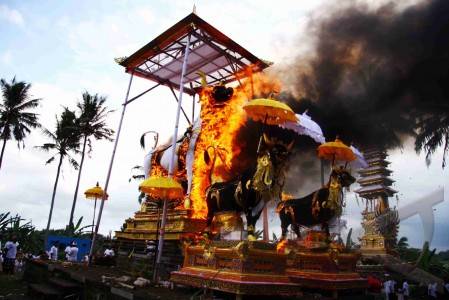Ngaben or Cremation Ceremony for Bali Hinduism
6 April 2006The ngaben, or cremation ceremony, is central to Bali Hinduism. The Balinese believe that burning the remains of the deceased in a cleansing fire will both return the elements of the body to earth and release the soul to enter heaven. An ngaben so vital to the well-being of the family and community that one may be performed even if the body is not available. In these cases, such as of the Bali Bomb victims who literally vanished in the fireball, an effigy is used.
If the family who has the corpse is financially well being, will hold the ngaben ceremony soon after the death. In most cases, an entire village will mount a joint ngaben every few years. Those who die in the interim are buried, later to be exhumed for cremation. One of more remarkable sights in Bali is a cemetery on the eve of an ngaben. People gather around open graves, carefully cleaning with their hands the bones of a beloved parent or grandparent. Cremation is viewed as a means for children to pay their debt to the parent who nurtured and protected them. Many Balinese attribute illness or misfortune to the mischief of an unsatisfied soul. Some families will hold a second cremation, using an effigy in place of actual remains, if the believe that a loved one was not given an appropriate send-off the first time.

A common cause of such spiritual dissatisfaction is a cremation performed on an inauspicious day. Mounting even a modest ngaben is a daunting exercise in logistics, as huge quantities of offerings, most incorporating expensive perishables such as sweetmeats, flowers, and fruit, must be prepared for use on a specific day determined by the fiendishly complicated Balinese religious calendar. Mistakes are not infrequent occurrences. The burning of the corpse or effigy and the accompanying rituals normally takes about four hours, followed by a procession to the sea, where the ashes are taken a short distance offshore and scattered to the waves. However, that is not the end of the ritual observances to aid the dead.
Twelve days after the cremation, a mamungkur ceremony is held to assist the soul, now unencumbered by the body to proceed to the upper world, where it will wait for reincarnation or, in the case of those who have attained spiritual purity in life, be absorbed onto nirvana.
In general, cremation falls into three categories: nista (lower), madya (middle), and utama (upper). While the utamaning utama (highest scale) rituals are reserved for royalty or high caste, nistaning nista (lowest scale) cremations are available for the lowest caste or even for non-Hindus.





















